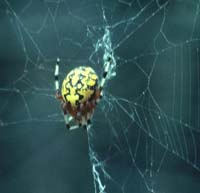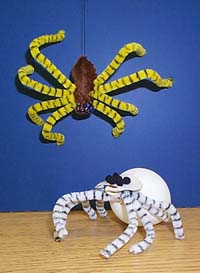|
|
Spider
Anatomy Lesson: Is It a Spider?
 Objectives: Objectives:
1) After studying the information in the ISM Spider Collection Online
introduction and other teacher's lessons on spider anatomy, students
will sort images to identify the spiders from a group of spiders and
insects according to three characteristics.
2) They will build a spider with art materials to demonstrate their
knowledge after learning about spider anatomy and how it is unique
compared with other creatures. /p>
Grade
Levels: K - 3
Time Required: Two class periods or 90 minutes (one to study
spiders, one to create)
Online
Resources:
Illinois State Museum's Spider Collection Online https://www.museum.state.il.us/ismdepts/zoology/collections/spiders/gallery.html
Motivation:
Spiders come in many shapes, colors, and sizes, but they all have characteristics
in common. We all know spiders have eight legs. What other characteristics
make a creature a spider, and not an insect?
1) Two body sections (an insect has three):
A) A cephalothorax (combination head and thorax), which contains the
brain, venom glands, and stomach, is covered by a shield called a carapace.
B) An abdomen, which contains the heart, lungs, digestive tract, reproductive
organs, and the silk glands.
2) Nearly all
spiders have four pairs of simple eyes.
3) Spiders have spinnerets that secrete a liquid that hardens into
"silk," which is used to make webs. The spinnerets are located on
the ventral side of the end of the abdomen.
Procedure:
Objective 1) The teacher or student gathers images of spiders and
insects from magazines, the Web, etc. Display the images of insects
and spiders. As the class sorts the images, pin spiders on the left
side of the board, non-spiders on the right.
*This could be an individual activity center project, where
students sort the images themselves and consult a key for the answers.
For pre-readers, the three characteristics can be presented as graphics.

Objective 2) Each student will choose among the art materials to construct
a model spider that has the physical characteristics listed above
(two body parts, eight eyes, spinnerets, chelicerae) after viewing
and sorting the spider images and reviewing the spider's anatomy.
They may choose to copy the shapes or coloring of spiders they saw
in the online collection (see examples in photos).
Optional
Art Materials:
balloons, construction paper, pipe cleaners, glue, scissors, buttons,
tempera or acrylic paint, small brushes, clays, string, twigs, yarn,
etc. See examples to the right.
Assessment:
1) Students will correctly identify spider images by sorting 90% or
more of the time during the activity.
2) Students will examine their art spiders and correctly point out
all the body parts that make it a spider.
Illinois
State Board of Education Goals and Standards Addressed: Science: Concepts:
Early Elementary
12.A.1a: Identify and describe the component parts of living
things (e.g., birds have feathers; people have bones, blood, hair,
skin) and their major functions.
12.A.1b: Categorize living organisms using a variety of observable
features (e.g., size, color, shape, backbone).
|

